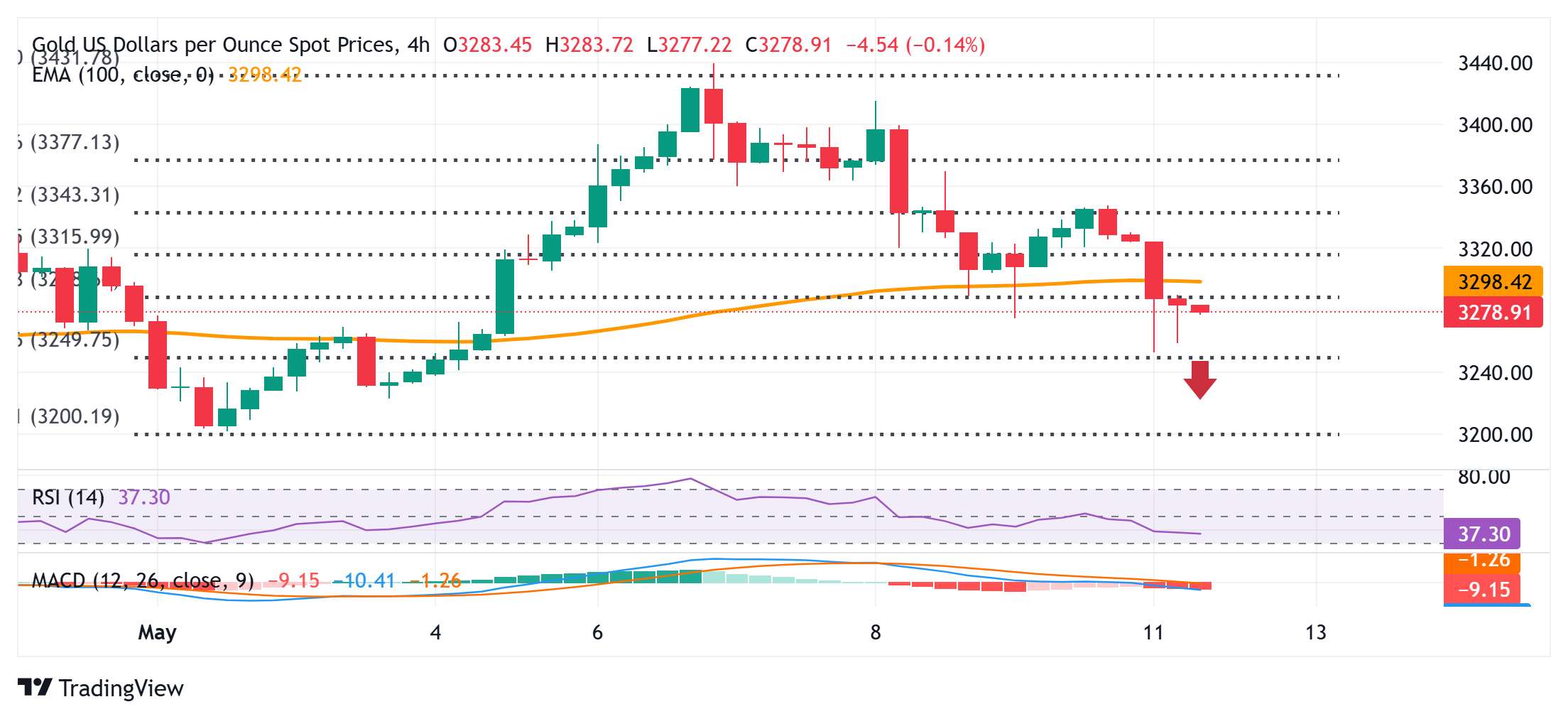Created
: 2025.05.12














![]() 2025.05.12 13:44
2025.05.12 13:44
Gold price (XAU/USD) attracts heavy selling on Monday and drops to a one-week low, around the $3,253-3,252 area during the Asian session on the back of US-China trade deal optimism. Positive signals from high-stakes US-China trade talks over the weekend in Switzerland boost investors' confidence and undermine demand for the traditional safe-haven bullion at the start of a new week. Furthermore, a modest positive development helps to ease market concerns about a recession in the US. This, along with the Federal Reserve's (Fed) hawkish pause earlier this week, assists the US Dollar (USD) to stand firm near a multi-week top and turns out to be another factor exerting pressure on the commodity.
The XAU/USD bears, however, seem reluctant to place aggressive bets and opt to wait for further details on the US-China trade talks. In fact, neither side mentioned an agreement to cut US tariffs of 145% on Chinese goods and China's 125% tariffs on US goods. This, in turn, assists the Gold price to rebound around $30 from the daily low, making it prudent to wait for strong follow-through selling before positioning for any further depreciating move. Moving ahead, this week's release of the latest US inflation figures, along with Fed Chair Jerome Powell's appearance on Thursday, will be looked for cues about the rate-cut path. This will influence the USD and provide a fresh impetus to the non-yielding yellow metal.

From a technical perspective, any intraday breakdown and acceptance below the $3,295-3,290 confluence - comprising the 100-period Exponential Moving Average (EMA) on the 4-hour chart and the 61.8% Fibonacci retracement level of the recent move up from the monthly low - could be seen as a key trigger for bearish traders. Moreover, oscillators on hourly charts have been gaining negative traction and support prospects for a further intraday depreciating move for the Gold price. Some follow-through selling below the Asian session low, around the $3,253-3,252 region, will reaffirm the bearish bias and expose the monthly low, around the $3,200 mark. The latter should act as a pivotal point, which, if broken decisively, should pave the way for the resumption of the prior retracement slide from the $3,500 psychological mark, or the all-time peak touched in April.
On the flip side, any recovery back above the $3,300 round figure now seems to attract fresh sellers near the $3,317-3,318 zone, or the Asian session peak. A sustained strength, however, might trigger a short-covering move and lift the Gold price to the $3,345-3,347 hurdle, representing the 38.2% Fibo. level. This is followed by the $3,360-3,365 static hurdle, which, if cleared decisively, would negate the near-term negative bias and set the stage for a move towards reclaiming the $3,400 mark.
Generally speaking, a trade war is an economic conflict between two or more countries due to extreme protectionism on one end. It implies the creation of trade barriers, such as tariffs, which result in counter-barriers, escalating import costs, and hence the cost of living.
An economic conflict between the United States (US) and China began early in 2018, when President Donald Trump set trade barriers on China, claiming unfair commercial practices and intellectual property theft from the Asian giant. China took retaliatory action, imposing tariffs on multiple US goods, such as automobiles and soybeans. Tensions escalated until the two countries signed the US-China Phase One trade deal in January 2020. The agreement required structural reforms and other changes to China's economic and trade regime and pretended to restore stability and trust between the two nations. However, the Coronavirus pandemic took the focus out of the conflict. Yet, it is worth mentioning that President Joe Biden, who took office after Trump, kept tariffs in place and even added some additional levies.
The return of Donald Trump to the White House as the 47th US President has sparked a fresh wave of tensions between the two countries. During the 2024 election campaign, Trump pledged to impose 60% tariffs on China once he returned to office, which he did on January 20, 2025. With Trump back, the US-China trade war is meant to resume where it was left, with tit-for-tat policies affecting the global economic landscape amid disruptions in global supply chains, resulting in a reduction in spending, particularly investment, and directly feeding into the Consumer Price Index inflation.
![]()
Created
: 2025.05.12
![]()
Last updated
: 2025.05.12

FXStreet is a forex information website, delivering market analysis and news articles 24/7.
It features a number of articles contributed by well-known analysts, in addition to the ones by its editorial team.
Founded in 2000 by Francesc Riverola, a Spanish economist, it has grown to become a world-renowned information website.
We hope you find this article useful. Any comments or suggestions will be greatly appreciated.
We are also looking for writers with extensive experience in forex and crypto to join us.
please contact us at [email protected].
Disclaimer:
All information and content provided on this website is provided for informational purposes only and is not intended to solicit any investment. Although all efforts are made in order to ensure that the information is correct, no guarantee is provided for the accuracy of any content on this website. Any decision made shall be the responsibility of the investor and Myforex does not take any responsibility whatsoever regarding the use of any information provided herein.
The content provided on this website belongs to Myforex and, where stated, the relevant licensors. All rights are reserved by Myforex and the relevant licensors, and no content of this website, whether in full or in part, shall be copied or displayed elsewhere without the explicit written permission of the relevant copyright holder. If you wish to use any part of the content provided on this website, please ensure that you contact Myforex.
Myforex uses cookies to improve the convenience and functionality of this website. This website may include cookies not only by us but also by third parties (advertisers, log analysts, etc.) for the purpose of tracking the activities of users. Cookie policy